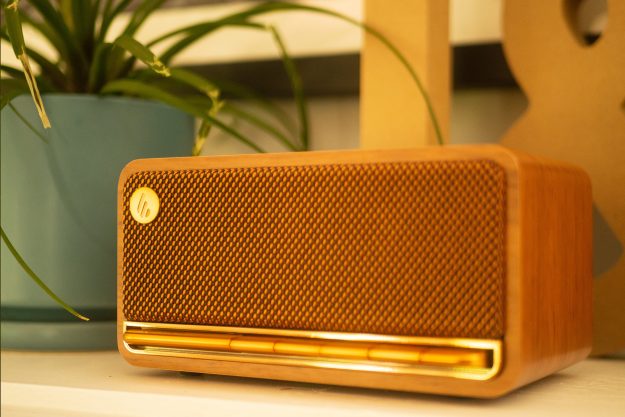
“The Definitive Technology Symphony 1 strikes an elegant balance between high-quality sound and strong features.”
- Comfortable fit
- Elegant design
- Clean, smooth lows and mids
- Wireless playback
- Muddled high end
- Might be tight for big heads
Sometimes you just want to kick back with your favorite album and tune the world out. If that’s what you’re into, the Symphony 1 want to help you out, and for a price, strips away the bells and whistles for a simple experience that’s both convenient and seamless. That’s reflected in their design too, which keep it classy and clean with a straightforward, jet-black exterior and subtle branding.
At $400, the Symphony 1 aren’t the cheapest set of cans around, but they do pack in the premium features. Between Bluetooth wireless connectivity, active noise canceling, and high-end audio drivers, it’s not hard to see why they carry a slightly elevated price tag. But do they really earn it?
Design
It may be my big noggin, but the band on the Symphony 1 is a little tight. In fact, I’m sure I have a big head, but the headband presses right in the center on the top of my head, just a little bit. Thankfully, it’s almost entirely offset by the squishiness of the padding. If you’ve got a normal-sized cranium, you should find the headphones to be very comfortable.
You’ll find that same plush padding on the Symphony 1’s earcups, which pull double duty by cushioning pressure around the ear, and relieving the headband of some of its duty. The padding also provides solid passive noise isolation, making the cans’ active noise cancelling feature just that much more effective. That isolation comes at a price, though, as things can get a little sweaty on especially warm days.
Controlling the Symphony 1 is managed through a set of six buttons, which sounds a little overwhelming, but is surprisingly intuitive. On the back of the right ear, three buttons, the middle of which has a bump to identify it, control the volume up and down, while the center button has a number of functions. Tap once to pause, once to play again, twice to skip a song, and three to go back to the last song. The other three buttons control pairing and power,
Ultimately, the thick padding on the headband and ear cup makes for a very comfortable fit, and one that you can wear for hours without discomfort. They look quite nice too, simple and understated, although there are some oddities. There’s a gap between the outer panels and the earcups that exposes some of the interior parts, and there’s a fair bit of resistance on the adjustable part of the headband that causes it to snap back in if not pushed all the way out and held there.
Features
One of the standout features of the headphones is their active noise-cancelling. It’s usually only seen on high-end
There’s a lot to love about the Symphony 1.
Bluetooth is an exciting feature for the Symphony 1, and one that really allows them to shine. Pairing is dead simple: just hold the Bluetooth button the first time to pair up, and after that the headphones quickly connect to any device they’ve paired with before in the area. If you don’t want to use Bluetooth, there’s a 3.5mm cable included for wired-up listening.
Audio
The audio performance of the Symphony 1 is defined by a clean, no-nonsense profile. Out of the box, they’re well suited for airier music, jazz or hip-hop with solid bass and well defined licks.
There’s little to complain about down at the low end of the spectrum. They won’t shake your ears off with bloated bass, but instead offer a well-tuned, smooth response. That smooth, defined response seems to get a little clouded toward the low end of the midrange, where some definition is lost
There’s nothing explicitly wrong with the mid-range on the Symphony 1, but it’s not as clean or present as the bass is. Vocals still pop, and particularly bright bits still shine through the clutter, but a lot of the other sounds in that range aren’t as distinct as they are at the low end. More rhythmic sounds that lack much pitch to begin with only lose that tonality, becoming more percussive.
At the very top of the treble, the sound starts to break up a bit, and is a bit more fragile than we’d like. Especially shimmery cymbals, for instance, wither among the firm, authoritative bass – a weakness for the Symphony 1, to be sure, though not an uncommon problem and certainly not one that’s going to make or break the Symphony 1.
On the whole, the Symphony are a rock-solid and stable set of headphones, both in terms of sound quality and build, but there is one oddity worth noting: When connected to a source over USB, the headphones’ built-in amplification is louder than average by a considerable amount. With our PC volume at ten percent, things were already quite loud, and approaching the halfway point is deafening. The same issue isn’t as prevalent over Bluetooth or 3.5mm audio connection, but it’s something to keep in mind if you like the idea of connected to your PC or laptop directly via USB..
What’s in the box
Like most high-end over ear headphones, the Symphony 1 comes with a carrying case, but lets you choose between an included hard shell and soft-sided case. Although you’re likely to use Bluetooth more often than not, the
Conclusion
The DT Accessory Pack
Up your game and the get the most out of your gear with the following extras, hand-picked by our editors:
Acrylic Headphones Stand ($12.76)
FiiO E6 Portable Headphone Amp ($28)
Avantree DG40S Bluetooth 4.0 USB Adapter ($13)
There’s a lot to love about the Symphony 1. The sound quality is very enjoyable, especially if your music choice makes heavy use of the lower range. Active noise cancelling is a welcome feature, and is implemented especially well in the Symphony 1. We just wish they held together a little better in the upper mids and treble. It should also be noted that these headphones are generally very comfortable, but depending on the size of your head, may put strain in weird areas.
At $400, the Symphony 1 also sits right in the middle of competing headphones in terms of price. The Bose QC25 cost a hundred dollars less, and have industry-leading noise cancelling. But while the sound on the QC25s is better than its predecessors, fidelity isn’t the headphone’s forte, and they don’t offer Bluetooth, giving Symphony 1 a bit of an edge in two departments. Then there’s the $500 Sennheiser Momentum Wireless, which put sound quality ahead of style, though they do add in noise-cancelling to justify their lofty price tag.
That puts the Definitive Technology Symphony 1 right smack in the middle of some very good company, leaving us to believe they’ll be a top choice for a wide range of listeners.
Highs
- Comfortable fit
- Elegant design
- Clean, smooth lows and mids
- Wireless playback
Lows
- Muddled high end
- Might be tight for big heads
Editors' Recommendations
- Sony’s ULT Power Sound headphones and speakers go big on powerful bass
- Best headphones for 2024: Sony, Bose, Apple, and more
- Jabra’s $100 Elite 4 are its most affordable ANC earbuds yet
- What is aptX? Cutting through the clutter of Qualcomm’s codecs
- MQair is the new hi-res Bluetooth audio codec for fans of MQA








